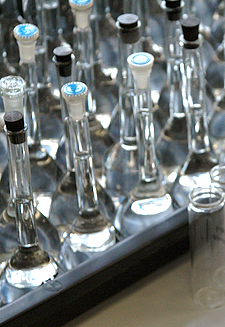PD Dr. Fidele Ntie-Kang

PD Dr. Fidele Ntie-Kang
Tel.:
E-Mail: ntiekfidele(at)gmail.com
Development of a Searchable Database for Natural Products from Africa and Nature-inspired Discovery of Potential Schistomiasis Drugs from African Medicinal Plants
The African continent is very rich in biodiversity and some of the medicinal plants growing on the continent have been used by its local populations in traditional preparations (marcerations, concoctions, infusions, incisions, steam baths, etc.) for the treatment of several ailments. The knowledge of the ethnobotanical uses of some of these plants has motivated research groups spread across the continent to engage in the isolation and characterisation of the natural products contained within the barks, roots, stems, leaves, etc. of the medicinal plants with the view of investigating the ethnobotanical uses and/or developing phytomedicines based on African medicinal plants. It is our aim within this study to make available (online) the current knowledge on ethnobotanical uses of the medicinal plants as well as the three dimensional (3D) structures, physico-chemical properties and measured activities of the compounds which have been isolated from medicinal plants in Central Africa, with the view of assisting in the drug discovery process.
The current proposal also includes epigenetic drug discovery against Schistosoma mansoni, targeting histone modifying enzymes. This will comprise zinc dependent histonedeacetylases (HDACs), NAD dependent histone deacetylases Sirtuins (Sirt2) and class 1 protein arginine/lysine methyltransferases (RMTs and KMTs). For most of the enzymes, crystal structures from mammalians are available in the PDB. S. mansoni histone deacetylase 8 (smHDAC8), for example, is a functional acetyl-L-lysine deacetylase that plays an important role in parasite infectivity and is therefore a relevant target for drug discovery. The determination of the atomic structures of smHDAC8 in complex with generic HDAC inhibitors revealed that the architecture of the smHDAC8 active site pocket differed significantly from its human counterparts and provided a framework for the development of inhibitors selectively interfering with schistosome epigenetic mechanisms. For the parasite enzymes only recently, the crystal structure of smHDAC8 has been solved by the SEtTReND consortium. For the other parasitic enzymes we will generate homology models to carry out docking experiments, followed by virtual screening, synthetic modifications of scaffolds and biological assays in vitro. Most promising molecules will be tested in vivo on cultures of S. mansoni and in Schistosoma infected mice in order to identify and validate useful lead compounds that could further be exploited and developed as candidate molecules that can progress to clinical trials.
Further information here: researchgate
Publications:
Full publication list here: Google Scholar





